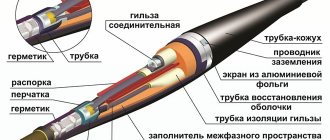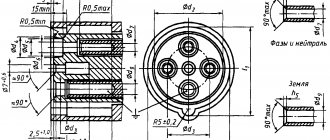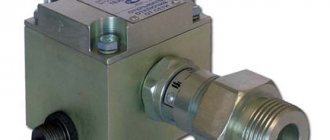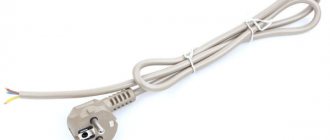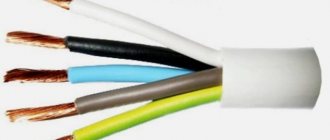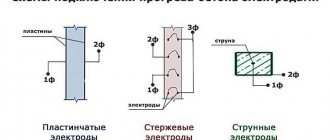Installation of cable joints
In cable routes, the joints are the most vulnerable point, so the requirements for them are no lower than for the cable itself. The connection of the cores is carried out using welding, soldering, crimping or bolting. Cable joints are used to restore the screen, insulation and armor. In addition to the actual insulation and protection of the spliced route section, installing cable sleeves allows you to solve two problems that arise when splicing cables. When connecting the cable, a section of the screen is removed. If it is not restored, the electrical characteristics of the route are disrupted. The unevenness of the electric field strength causes concentration and localization of power lines, and the resulting ionization leads to breakdown and failure of the entire cable line. The second problem is the occurrence of tracking phenomena at the joints. Pollution of the atmosphere and industrial premises leads to the deposition of dirt on the insulation and the formation of conductive paths. The consequences are the same - breakdown of the connection point and failure of the line. According to their purpose, cable couplings are divided into: • connecting couplings (used to connect pieces of the cable route); • branch lines (for connecting the cable line to the main line); • end (for connecting electrical installations). Mast end couplings are required for connection to overhead power lines. Cable sleeves are: • lead, • made of epoxy mixtures, • heat-shrinkable • cold-shrinkable. The sleeve must provide resistance to the environment, mechanical and electrical strength, be sealed and moisture-resistant. These requirements are best met by hot and cold shrink couplings used to connect cables with any insulation. Their use allows you to reduce labor and time costs and carry out work in tight spaces. These seemingly similar couplings differ in physical properties, installation methods and applications. Heat-shrinkable sleeves can be used for any method of laying cable lines, they have a long service life - more than 30 years, and are easy to install. One standard size of heat-shrink sleeve can be used for different sections of cores and types of cables; their fittings are practically not subject to aging and can be stored indefinitely. Heat-shrinkable sleeves have high rigidity and are resistant to most aggressive environments, but require UV protection. Cold shrink couplings have all the advantages of heat-shrinkable couplings, but do not require heating during installation; this reduces the installation time of the coupling by approximately 2 times. During cold shrinkage, silicone or EPDM rubber is used as an insulating material. Silicone is UV resistant and repels water, but is not very abrasion resistant. EPDM rubber cable sleeves are more durable, but require additional protective measures against UV radiation. At the point of connection with thermo- and cold-shrinkable couplings, the flexibility of the cable is maintained, they are resistant to cyclic temperature changes and seasonal soil movements, their tensile strength is 60% of the tensile strength of the cable itself. When carrying out work on cable lines, it is optimal to combine both technologies. Installation of heat-shrinkable cable sleeve
Before installing the coupling, the end of the cable is cut: sequentially, with some shift, all its layers are removed, starting from the outer protective coating to the phase insulation of each core.
The cutting dimensions are strictly regulated, depend on the cross-section and brand of cable cores, line voltage, and are given in reference books and installation instructions. The heat shrink sleeve kit includes: tubes, cuffs, hoses, gloves and other elements supplied in an extended state. During installation, they are easily put on the elements of the cut cable. Heating with a construction hairdryer or torch causes the parts to shrink; they tightly envelop the cable elements and provide mechanical strength to the structure. The shrinkage temperature is 120-150°C, it is not dangerous for insulation. When heated, sealants applied to the internal surfaces of the coupling parts melt, fill the voids and seal the joint. Sealants contain special additives that level the electric field at the point of contact. This protects the connection from breakdown. The installation diagram for the heat-shrinkable end sleeve of a single-core cable is shown in the figure: a - stripped cable; b - shrinkage of the tube that equalizes the electric field; c - shrinkage of the vein cuff; g - connecting the grounding conductor and shrinking the hose; d - shrinkage of the end collar; e - shrinkage of the waist cuff. Installation of a three-core cable is carried out in the same way, but instead of heat-shrinkable tubes, heat-shrinkable gloves are used. They are put on the 3-phase cores of a pre-cut cable. Installation of a cold-shrinkable cable sleeve
A cold-shrinkable sleeve is a pre-stretched product placed on a spiral-shaped plastic cord. As the spiral is removed, the sleeve fits tightly around the cable, providing a complete seal. The thick walls of the coupling reliably protect against mechanical influences. The figure shows a cold-shrinkable coupling for a single-core cable: 1 - housing; 2 - plate with a layer of semiconductor material; 3 – protective casing; 4 – mastic, leveling the electric field; 5 - sealant; 6 — screen; 7 - connecting sleeve. The installation diagram of such a coupling is shown in the figure: a - preparation of screens; b - connection of cores; c — overlay at the junction of the plate leveling the electric field; d - putting the coupling on the junction of the cores; d - removal of the spiral cord; e - the connection is ready to apply voltage.
Composition of the shrink kit
DSG 6/2 Heat-shrinkable tube, Ø 6 mm, length 120 mm
The tube is divided into three 40 mm parts to connect the heating conductors of the heating cable with the conductors of the power wire, as well as the braid with the grounding conductor inside the coupling.
DSG 16/4 Heat-shrinkable tube, Ø 16 mm, length 150 mm
The external heat-shrinkable tube in the connecting sleeve covers all connections of the heating cable and the supply wire.
DSG 12/3 Heat-shrinkable tube, Ø 12 mm, length 170 mm
Divided into three parts: 70mm - closes the connection of two current-carrying wires of the heating cable with two current-carrying wires of the supply wire.
Sealing the cable end
Using a knife, 20 mm of the outer sheath of the heating cable is removed. The shell is easy to cut, so you should not use much effort when making cuts.
Using a sharp object, the protective braiding is unraveled. It must be removed, leaving 5 mm at the edge of the outer shell. To carefully remove the braid, you can gather it into a bundle, twist it and cut off the excess part with side cutters.
It is necessary to make a “step” at the edge of the cable using side cutters, thereby providing additional protection against short circuits between the current-carrying conductors. Next, you need to cover the resulting section with a heat-shrinkable tube DSG 12/3, taking a 40mm part.
The tube must be pushed so that the edge of the outer sheath of the cable is completely hidden on one side, and the tube extends 5 mm beyond the free edge of the cable in order to clamp the tube with pliers after heat shrinking with a hairdryer.
The tube is heat-shrinked with a hairdryer at a temperature of 200°C, starting from the middle to the edges, so as not to move the coupling. This is the first layer of heat shrink on the cable termination. After the tube tightly crimps the cable, it is necessary to make a pinch at its end, sealing the tube. In this case, glue should appear on both edges of the tube.
Next, a piece of DSG 12/3 tube, part 60mm, is put on the resulting sealed connection. The tube is pushed in such a way as to cover the edges of the first layer of insulation. There should also be about 10mm of free edge of the tube left to clamp it with pliers after heating.
The tube should tightly press the edge of the cable with the first layer of insulation. After the tube is heat-shrinkable, the free edge is hot clamped with pliers. So that the glue comes out at the end of the coupling.
This creates a completely sealed section with installation wire and termination, ready for installation.
If the section will be connected to the power supply through a socket, it is necessary to install a plug at the end of the supply wire. We recommend connecting sections no longer than 20m to the network in this way. In other cases, the section is connected through an RCD or a differential circuit breaker.
Checked by: Evgeniy Shchipunov
Chief Engineer of SKO Alfa Project LLC
Advantages of MKT
Installation of cable terminations in the form of ready-made factory-made kits has a number of undeniable advantages over older types of connectors. This is explained by the emergence of new advanced synthetic materials over the past decades.
The delivery package of finished products takes into account every step of the technological process for creating the cable end layout. The advantages of universal kits for terminating cable connections are as follows:
- absolute sealing of cores and joints is created;
- heating the heat-shrinkable material compresses the new sheath of the separated ends of the cable until a dense and durable insulating layer is obtained;
- the end coupling has high heat resistance and immunity to aggressive environments;
- ease of installation allows semi-skilled specialists to perform the work;
- couplings ensure environmental safety of the surrounding area;
- the use of accompanying cleaning materials in the installation of couplings allows workers to remain with clean hands;
- guarantees, the service life of MKT reaches 30 years.
Note! Heat-shrinkable end sleeves are quick and easy to install compared to pour-in devices and cold-shrinkable products. However, it is worth noting that MKTs are much more expensive than their analogues
